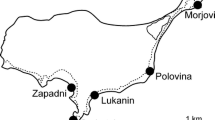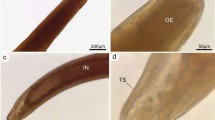Abstract
Anisakids belong to a genus of parasitic nematodes with a life cycle involving fish and marine mammals. They cause anisakidosis (anisakiasis) by accidental ingestion of larval stage (Anisakis and other Anisakids), causing both gastrointestinal and allergic reaction in human. The aim of the current study was to report the finding of Hysterothylacium amoyense in Platycephalous indicus fishes and also its probable pathologic effect on a mouse model. In this regard, a total of 27 live third stage larvae ranging from 1.5 to 3 mm in length were collected from gut submucosa of the fish Platycephalous indicus [ZAMIN KAN] and washed up by saline 6 %, and two were characterized as Hysterothylacium amoyense by morphologic and molecular techniques. A total of 25 larvae were orally fed to 5 inbred mice (each 5). A total of 5 mice were also selected as control group; they did not receive the larvae. After 2 weeks, all mice were necropsied using ethical protocol of SUMS. Their specimens, both gross and histologic, were observed and described. Tumor-like nodules were observed in 3 out of 5 infected mice group which could be misdiagnosed as cancer. Microscopic examinations showed lymphocytic infiltration. No pathologic changes were found in the control group. The results showed an invasive anisakid, Hysterthylacium amoyense, with histopathologic features observed in the mammal model (mouse). The parasite has been found in benthic fish Platycephalous indicus in the Persian Gulf, Bushehr region, southern Iran. The parasite could be regarded as a possible source of anisakidosis in coastal populations and should be regarded as a public health problem.







Similar content being viewed by others
References
Audicana MT, Kennedy MW (2008) Anisakis simplex: from obscure infectious worm to inducer of immune hypersensitivity. Clin Microbiol Rev 21:360–379
Bonne C, Sandground J (1939) On the production of gastric tumors, bordering on malignancy, in Javanese monkeys through the agency of Nochtia nochti, a parasitic nematode. The American Journal of Cancer 37:173–185
Cho S-W, Lee HN (2006) Immune reactions and allergy in experimental anisakiasis. The Korean journal of parasitology 44:271–283
Chung J, Kuo H, Lin T, Ho C, Lee J, Lai J, Levy G, Weber W (1996) Evidence for arylamine N-acetyltransferase in the nematode Anisakis simplex. Cancer Lett 106:1–8
Fagerholm, H.-P. (1982) Parasites of fish in Finland. VI. Nematodes, Vol 40
Fagerholm HP (1991) Systematic implications of male caudal morphology in ascaridoid nematode parasites. Syst Parasitol 19:215–229
Fang W, Xu S, Zhang S, Wang Y, Chen X, Luo D (2010) Multiple primer PCR for the identification of anisakid nematodes from Taiwan Strait. Exp Parasitol 124:197–201
FAO/WHO, R.O.A.J (2012) Multicriteria-based ranking for risk management of food-borne parasites. microbiologicalriskas,sessmentseries 23:64
Farjallah S, Merella P, Ingrosso S et al (2008) Molecular evidence for the occurrence of Contracaecum rudolphii A (Nematoda: Anisakidae) in shag Phalacrocorax aristotelis (Linnaeus) (Aves: Phalacrocoracidae) from Sardinia (western Mediterranean Sea). Parasitol Int 57(4):437–440
Gopar-Merino L, Osorio-Sarabia D, García-Prieto L (2005) A new species of Hysterothylacium (Nematoda: Anisakidae) parasite of Ariopsis guatemalensis (Osteichthyes: Ariidae) from Tres Palos lagoon, Mexico. J Parasitol 91:909–914
Hochberg NS, Hamer DH, Hughes JM, Wilson ME (2010) Anisakidosis: perils of the deep. Clin Infect Dis 51:806–812
Ishikura H (1969) Occurrence of anisakiasis and its clinical presentation. Saishin Igaku 24:357–365
Ishikura, H., Kikuchi, K., Nagasawa, K., Ooiwa, T., Takamiya, H., Sato, N., and Sugane, K. (1993) Anisakidae and anisakidosis. In Progress in clinical parasitology (Springer), pp. 43–102
Ito Y, Ikematsu Y, Yuzawa H, Nishiwaki Y, Kida H, Waki S, Uchimura M, Ozawa T, Iwaoka T, Kanematsu T (2007) Chronic gastric anisakiasis presenting as pneumoperitoneum. Asian Journal of Surgery 30:67–71
Iwasaki K, Torisu M (1982) Anisakis and eosinophil: II. Eosinophilic phlegmon experimentally induced in normal rabbits by parasite-derived eosinophil chemotactic factor (ECF-P). Clin Immunol Immunopathol 23:593–605
Jones RE, Deardorff TL (1990) Anisakis simplex: histopathological changes in experimentally infected CBA/J mice. Exp Parasitol 70:305–313
Kassai T, Del Campillo MC, Euzeby J, Gaafar S, Hiepe T, Himonas C (1988) Standardized nomenclature of animal parasitic diseases (snoapad). Vet Parasitol 29:299–326
Knoff M, Felizardo NN, Iñiguez AM, Maldonado A Jr, Torres EJ, Pinto RM, Gomes DC (2012) Genetic and morphological characterisation of a new species of the genus Hysterothylacium (Nematoda) from Paralichthys isosceles Jordan, 1890 (Pisces: Teleostei) of the Neotropical Region, state of Rio de Janeiro, Brazil. Mem Inst Oswaldo Cruz 107(2):186–193
Kong Q, Fan L, Zhang J, Akao N, Dong K, Lou D, Ding J, Tong Q, Zheng B, Chen R (2015) Molecular identification of Anisakis and Hysterothylacium larvae in marine fishes from the East China Sea and the Pacific coast of central Japan. Int J Food Microbiol 199:1–7
Kuhn T, García-Màrquez J, Klimpel S (2011) Adaptive radiation within marine anisakid nematodes: a zoogeographical modeling of cosmopolitan, zoonotic parasites. PLoS ONE 6(12), e28642
Li L, Xu Z, Zhang L (2008) Redescription of three species of Hysterothylacium (Nematoda: Anisakidae) from marine fishes from the Yellow Sea, China, with the synonymy of Hysterothylacium muraenesoxin (Luo, 1999). Zootaxa 1878:55–67
Moravec F, Nagasawa K, Ogawa K (1998) Observations on five species of philometrid nematodes from marine fishes in Japan. Syst Parasitol 40:67–80
Motta, M.R.A., Pinheiro, D.C.S.N., Carvalho, V.L., Viana, D.D.A., Vicente, A.C.P., and Iñiguez, A.M. (2008) Gastric lesions associated with the presence of Anisakis spp. Dujardin, 1845 (Nematoda: Anisakidae) in Cetaceans stranded on the coast of Ceara, Brazil. Biota Neotropica 8, 0–0
Muller R (2002) Worms and human disease. A manual of medical helminthology. doi:10.1079/9780851995168.0000
Nadler SA, Hudspeth DS (1998) Ribosomal DNA and phylogeny of the Ascaridoidea (Nemata: Secernentea): implications for morphological evolution and classification. Mol Phylogenet Evol 10(2):221–236
Ohtaki, H., and Ohtaki, R. (1989) Clinical manifestation of gastric anisakiasis. In Gastric anisakiasis in Japan (Springer), pp. 37–46
Overstreet, R.M., and Meyer, G.W. (1981) Hemorrhagic lesions in stomach of rhesus monkey caused by a piscine ascaridoid nematode. The Journal of parasitology, 226–235
Pontes T, D’Amelio S, Costa G et al (2005) Molecular characterization of larval anisakid nematodes from marine fishes of Madeira by a PCR-based approach, with evidence for a new species. J Parasitol 91(6):1430–1434
Quiazon K, Yoshinaga T, Santos M et al (2009) Identification of larval Anisakis spp. (Nematoda: Anisakidae) in Alaska pollock (Theragra chalcogramma) in northern Japan using morphological and molecular markers. J Parasitol 95(5):1227–1232
Raybourne R, Deardorff TL, Bier JW (1986) Anisakis simplex: larval excretory secretory protein production and cytostatic action in mammalian cell cultures. Exp Parasitol 62:92–97
Romero M, Valero A, Navarro-Moll MC, Martín-Sánchez J (2013) Experimental comparison of pathogenic potential of two sibling species Anisakis simplex ss and Anisakis pegreffii in Wistar rat. Tropical Med Int Health 18:979–984
Sadjjadi SM, Oryan A, Jalai AR, Mehrabani D (2001) Prevalence and intensity of infestation with Toxocara cati in stray cats in Shiraz, Iran. Veterinarski Arhiv 71:149–157
Skovgaard A, Bahlool QZ, Munk P, Berge T, Buchmann K (2011) Infection of North Sea cod, Gadus morhua L., larvae with the parasitic nematode Hysterothylacium aduncum Rudolphi. J Plankton Res 33(8):1311–1316
Szostakowska B, Myjak P, Kur J, Sywula T (2001) Molecular evaluation of Hysterothylacium auctum (Nematoda, Ascaridida, Raphidascarididae) taxonomy from fish of the southern Baltic. Acta Parasitol 46(3):194–201
Szostakowska B, Myjak P, Kur J (2002) Identification of anisakid nematodes from the Southern Baltic Sea using PCR-based methods. Mol Cell Probes 16(2):111–118
Sakanari J, Loinaz H, Deardorff T, Raybourne R, McKerrow J, Frierson JG (1988) Intestinal anisakiasis. A case diagnosed by morphologic and immunologic methods. Am J Clin Pathol 90:107–113
Shih H-H, Jeng M-S (2002) Hysterothylacium aduncum (Nematoda: Anisakidae) infecting a herbivorous fish, Siganus fuscescens, off the Taiwanese coast of the Northwest Pacific. zoological studies-Taipei 41:208–215
Smetana, H.F., and Orihel, T.C. (1969) Gastric papillomata in Macaca speciosa induced by Nochtia nochti (Nematoda: Trichostrongyloidea). The Journal of parasitology, 349–351
Tsutsumi Y, Fujimoto Y (1983) Early gastric cancer superimposed on infestation of an anisakis-like larva: a case report. Tokai J Exp Clin Med 8:265–273
Yagi K, Nagasawa K, Ishikura H, Nakagawa A, Sato N, Kikuchi K, Ishikura H (1996) Female worm Hysterothylacium aduncum excreted from human: a case report. Jpn J Parasitol 45(1):12–23
Zahabiun F, Sadjjadi SM, Esfandiari F (2015) Development of a double glass mounting method using formaldehyde alcohol azocarmine lactophenol (FAAL) and its evaluation for permanent mounting of small nematodes. Iran J Parasitol 10:617–624
Zhu X, Gasser RB, Jacobs DE, Hung G-C, Chilton NB (2000) Relationships among some ascaridoid nematodes based on ribosomal DNA sequence data. Parasitol Res 86:738–744
Acknowledgments
This project was financially supported by the office of vice-chancellor for research at Shiraz University of Medical Sciences, Grant No: 93-7252. Technical assistance of Mr. Abouzar Valizadeh and Mr. Mohammad Mehdi Ommati are acknowledged. The authors thank Prof. S. Sajjadi for his valuable assistance.
Author information
Authors and Affiliations
Corresponding author
Ethics declarations
Conflict of interest
The authors declare that they have no conflict of interest.
Research involving human participants and/or animals
This protocol was performed in accordance with the international guiding principles for biomedical researchers involving laboratory animals at Shiraz University of Medical Sciences, Shiraz, Iran (code: ec:9372-7252).
Informed consent
The present study had no tests on human.
Rights and permissions
About this article
Cite this article
Najjari, M., Sadjjadi, S.M., Derakhshanfar, A. et al. Hysterothylacium amoyense in Platycephalous indicus: a Persian Gulf fish and its experimental infection of mouse model. Comp Clin Pathol 25, 1143–1149 (2016). https://doi.org/10.1007/s00580-016-2318-x
Received:
Accepted:
Published:
Issue Date:
DOI: https://doi.org/10.1007/s00580-016-2318-x




